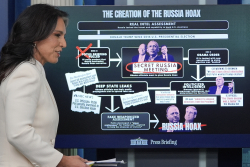The B-21’s low initial production rate was not only aimed at getting the aircraft right, but also to shield it from deep budget cuts.
The second B-21 Raider test aircraft will be flying “shortly,” the head of Air Force Global Strike Command, General Thomas A. Bussiere, told Air & Space Forces Magazine on July 25. The first B-21 has been flying about twice per week since its maiden flight in November 2023.
The Air Force says that at least six B-21s are under construction, though the exact number is classified.
Bussiere noted that the B-21’s development has been deliberately measured, rather than a “reach-for-the-stars” technological leap. Such starry-eyed endeavors have a history of delays and problems leading to later implementation and operational issues. The B-21 is meant to apply new stealth technologies with lessons learned from the B-2 Spirit stealth bomber.
The result is an advanced, capable aircraft designed to maximize serviceability rates through ease of maintenance, a lesson derived from the B-2 program. The B-21’s low initial production rate was not only aimed at getting the aircraft right, but also to shield it from deep budget cuts of the kind that reduced the B-2 from 132 planned aircraft to 20. “Usually, programs get at risk when they get delayed or they have trouble in technology or capability or capacity in the production phase,” Bussiere said. Though a different situation, the F-35 is experiencing those kinds of cuts right now.
Pilots and maintenance personnel advised the design team, optimizing things like displays, cockpit controls, the placement of access panels, and subcomponent access for easy maintenance. The goal is to make the B-21 less maintenance-intensive than the B-2, which should lead to greater operational availability and lower costs. The B-2’s availability is also affected by its stealth characteristics, which usually require attention before the aircraft can fly again. The B-21 looks to eliminate that issue.
Aircraft availability is a significant aspect of the B-21 program, with global tensions rising and availability issues on other platforms becoming a problem.
B-21 production was initially set at 100 aircraft in 2018, but the global strategic situation has changed drastically over the past half-decade, with the onset of war in Ukraine War, Iran’s nuclear ambitions, and China’s force expansions. Bussiere, along with US Strategic Air Command Head General Anthony Cotton and other experts, has called for at least 145 B-21s to meet those challenges.
Bussiere speculated that the need for more B-21s speaks to “a great realization of the value and prominence of long-range strike and the ability to hold at risk anything on the planet at the time and place of our choosing.” New systems to replace the aging B-2, B-52, and B-1 bombers are imperative to preserve and extend that capability while maintaining a legacy bomber fleet. Bussiere stressed that no one could look at the current world situation and not conclude that more long-range strike capability is needed.
America’s recent “Operation Midnight Hammer,” a bombing raid carried out by the US Air Force against Iranian nuclear facilities, seems to bear out Bussiere’s statement, though how the Raider stacks up against peer or near-peer opposition remains to be seen. Several nations, including the United States, are pursuing sixth generation air superiority aircraft, though those platforms are not expected to enter service until the mid-2030s or even 2040.
Some classify the B-21 as a sixth-generation aircraft, though its reliance on upgraded fifth-gen technology optimized for strategic bombing might be more appropriately called “fifth gen plus.” The B-21 will be certified for nuclear and conventional missions from the outset, unlike the B-2, which was initially only certified for the nuclear role. Conventional certification came later.
Northrop Grumman, Air Force Materiel Command, and Headquarters, US Air Force are all looking at the best way to increase production capacity, with $4.5 billion in increased funding for materials and infrastructure coming from President Donald Trump’s so-called “Big Beautiful Bill.” The production rate, however, will remain relatively low. The exact rate is classified, but recent defense reports and budgets suggest the maximum rate would be about seven aircraft per year.
The Air Force expects the B-21 to reach Initial Operational Capability in 2027, with combat-ready B-21 units deployed by 2030.
About the Author: William Lawson
William Lawson is a military historian focusing on World War II and 20th century conflicts and the American Civil War. His specialty is operational level warfare, especially American amphibious doctrine. He writes on history, politics, and firearms for multiple publications and historical journals. He serves on the editorial advisory board for the Saber & Scroll Journal and Military History Chronicles and is a member of the Society for Military History and the American Historical Association. Lawson is based in Virginia.
Image: Wikimedia Commons.


















